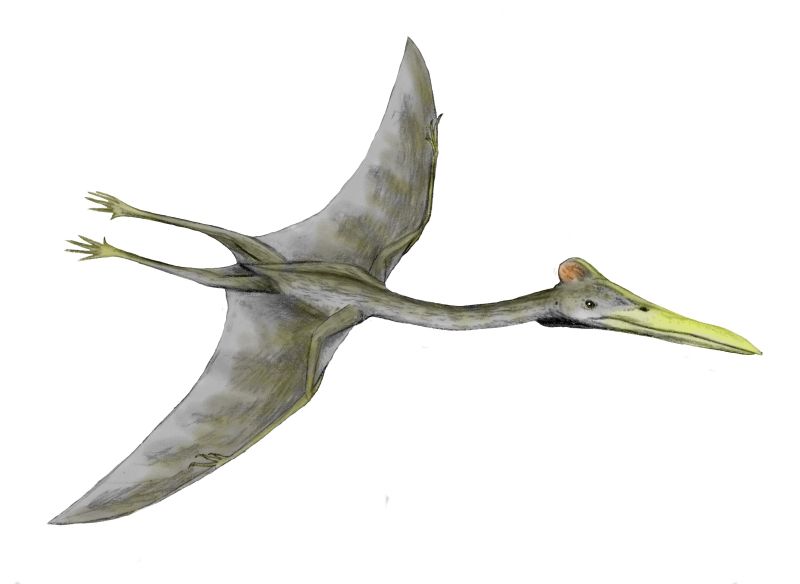- Hatzegopteryx
Taxobox
name = "Hatzegopteryx"
fossil_range = Fossil range|65.5Late Cretaceous

image_width = 200px
image_caption =
regnum =Animal ia
phylum = Chordata
classis = Sauropsida
ordo =Pterosauria
subordo =Pterodactyloidea
familia =Azhdarchidae
genus = "Hatzegopteryx"
genus_authority = Buffetaut, Grigorescu & Csiki, 2002
subdivision_ranks =Species
subdivision ="H. thambema" Buffetaut, Grigorescu & Csiki, 2002 (type)Hatzegopteryx ("
Haţeg basin wing") is agenus of azhdarchidpterosaur , known from incomplete remains found inTransylvania . The skull fragments, left humerus, and otherfossil ized remains indicate a huge animal with a wingspan of 12 meters (40 ft) or more. It is known from only the type species, "Hatzegopteryx thambema". The generic name derives from the "Hatzeg" (or Haţeg) basin of Transylvania where the bones were found, and from the Greek "pteryx", or 'wing'. The specific name "thambema" derives from the Greek for 'monster', in reference to its huge size."Hatzegopteryx" hails from the
Densus-Ciula Formation of westernRomania , which has been dated to the lateMaastrichtian stage of the lateCretaceous Period, around 65 million years ago. A 35.5 centimeterfemur found nearby may also have belonged to "Hatzegopteryx".kull
"Hatzegopteryx" apparently had a robust skull broadened in the rear, and a massive jaw. Its lower jaw featured a unique groove in its point of articulation, also seen in some other pterosaurs, that would have allowed the animal to achieve a very wide gape. Many of the fossilized bones of "Hatzegopteryx" closely resemble those of the closely related "
Quetzalcoatlus ", though in "Hatzegopteryx" the skull was much more heavily built, and had a markedly different jaw articulation similar to that seen in "Pteranodon ". Based on comparisons with other pterosaurs, Buffetaut and colleagues (who initially described the specimens) estimated that the skull of "Hatzegopteryx" was probably almost 3 m (9.8 ft) in length, which would have made it larger than that of the largest "Quetzalcoatlus" species and among the largest skulls of any known non-marine animals.Buffetaut, E., Grigorescu, D., and Csiki, Z. (2002). "A new giant pterosaur with a robust skull from the latest Cretaceous of Romania." "Naturwissenschaften", 89(4): 180-184. [http://www.springerlink.com/content/w55xf7hvvmwp6t5c/ Abstract] ]The skull of "Hatzegopteryx" was also unique in its heavy, robust construction. Most pterosaur skulls are made up of very lightweight plates and struts. In "Hatzegopteryx", the skull bones are stout and robust, with large-ridged muscle insertion areas. In their 2002 description, Buffetaut and colleagues suggested that in order to fly, the skull weight of this pterosaur must have been reduced in some unconventional way (while they allowed that it could have been flightless, they found this unlikely due to the similarity of its wing bones to flying pterosaurs). The authors theorized that the necessary weight reduction was accomplished by the internal structure of the skull bones, which were full of small pits and hollows ("alveoli") up to 10mm long, separated by a matrix of incredibly thin bony struts ("trabeculae"), a feature also found in some parts of "Hatzegopteryx" wing bones. The authors pointed out that this unusual construction, which differed significantly from the irregular internal structure of other pterosaur skulls, resembles the structure of expanded polystyrene, the substance used to make
Styrofoam . They noted that this would allow a sturdy, stress-resistant construction while remaining lightweight, and would have allowed the huge-headed animal to fly.References
External links
* [http://www.pterosaur.co.uk/species/UCP/Azhd/Hatzeg-thambema.htm "Hatzegopteryx" at The Pterosaur Database]
Wikimedia Foundation. 2010.
